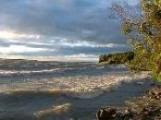Residents monitoring creeks along Simcoe’s northeast shore
Paddling up Murphy’s Creek on a spring morning, Stephen Bimm enters a world of extraordinary natural variety he calls The Zone.
Guiding his red canoe through “a maze of Everglade-style canals,” past cattails, bulrush, willow, silver maple, spruce and pine, the Plum Point resident encounters as many as a half-dozen curious otters, swimming or standing on their haunches to stare, along with beavers, minks, muskrats, great blue herons, green herons and many other wetland creatures.
“The stillness, the freshness, the abundant wildlife — it’s unbelievable,” says Bimm.
Murphy’s Creek, which flows into McPhee Bay, is one of five creeks along the northeast shore of Lake Simcoe that has been monitored by the North Mara Beach Ratepayers for the last few years.
An electrician by trade, Bimm is the group’s environmental co-ordinator.
“Because I have a beer fridge for the water samples,” he quips.
Four years ago, concerned about the lack of data at the northeast end of Lake Simcoe, the ratepayers began taking monthly water samples from four creeks — Murphy’s, Wainman, Water Lily and Glen Rest Creek as well as the Talbot River.
The idea was to establish baseline readings for phosphorous, nitrogen and E. coli in the creeks, said Bimm.
“We wanted to build a database because the conservation authority was not paying attention to the north end of the lake.”
The first two years, the ratepayers paid for the laboratory tests themselves.
But last year and again this year, the Lake Simcoe District Conservation Authority has agreed to pick up the $2,695 lab costs.
Advertisement
LATEST IMAGES
Entire Album
` Twice in four years the tests have revealed elevated levels of E. coli in two of the creeks, and phosphorous levels are at times higher than desirable, but for the most part there has been nothing suggesting declining water quality in the test results.
The sense is the pollutants in the creek and the lake as a whole have plateaued, said Neil Roe, president of the ratepayers association.
Like many other longtime lake watchers, Bimm and Roe see causes for optimism and reasons for concern about the water quality in the Lake Simcoe watershed.
Many species of birds that feed on fish such as osprey are flourishing and swans and green heron are more abundant, suggesting a good food supply.
On the other hand, the condition of water in the lake seems to have deteriorated in the two decades, said Bimm.
When he bought his waterfront property on Plum Point in the 1980s, blue-green algae was rare.
“Now we can have four or five blooms a year.”
And the algae, which releases hazardous toxins, seems to appear earlier each year.
“I put my sailboat in the water this spring and I could have walked on blue-green algae.”
There are more weeds in the lake
“Overall, everybody is concerned.”
The formation of many environmental groups around Lake Simcoe is cause for optimism, as well as the commitment from both the federal and provincial governments to focus resources on improving water quality.
On the other hand, people seem slow to grasp the implications of their actions by continuing to use dish and laundry detergent and other cleaning products containing phosphorous and fertilizer containing nitrogen that stimulate the algae and weed growth in the lake, said Roe.
Antibacterial soap can also degrade the environment by destroying bacteria that plays a beneficial role breaking down plant and vegetable matter, said Roe.
“Joe Blow still doesn’t get it.”
Bimm says controlling development will be a key to protecting the lake.
At one time there were plans to turn the Murphy Creek wetland into a Lagoon City-style development with homes lining a man-made canal system, said Bimm.
That kind of development is thankfully now prohibited, he said.
But there will continue to be development pressures, particularly along the shore.
Having base-line data for the creeks that might be affected and a greater understanding of the lake’s ecosystems will help municipalities, residents associations and developers plan responsibly, said Roe.
“You can’t stop progress,” said Bimm.
“Otherwise none of us would be living on the shores of this beautiful lake.”
But as new projects come along, an informed populace can participate more effectively, said Bimm.
“Groups like ours can pose the questions.”



